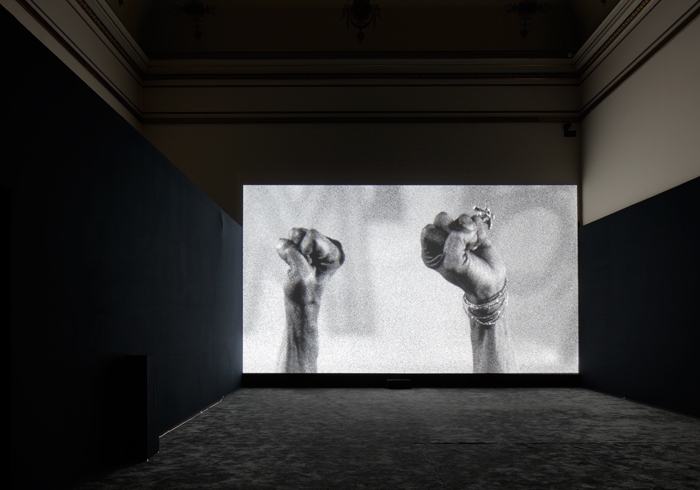This presentation of Arthur Jafa’s touring exhibition, which moves through the Rudolfinum’s horseshoe-shaped first floor, opens with his best-known work: Love is the Message, the Message is Death (2016). Already widely seen as an iconic artwork of its era, this seven-minute film contains short clips from silent movies and later Hollywood films, marches, concerts and sports events, news stories, police dashcams, citizens’ journalism and Jafa’s own home movies, cut to the sound of Kanye West’s Ultralight Beam (2016). The focus on the materiality of black bodies, as a means of making the seemingly paradoxical political assertion that black people are more than just things, is implied by other works in the show, including Jonathan, Black Flag and Pledge of Allegiance 1848 (all 2017). Each places images of black bodies in white spaces or stories in order, Jafa explains in an interview with Hans Ulrich Obrist in the exhibition catalogue, to produce ‘contextual dissonance’.
Jonathan is a huge, wall-length, black-and-white photograph of the 1970 Marin County Courthouse incident. A nervous, boyish-looking Jonathan Jackson tries to negotiate freedom for his brother George, the Marxist Black Panther-supporting author, by abducting Judge Harold Haley. George was part of the Soledad Brothers group, accused of killing a white prison guard in retaliation for the deaths of three black prisoners some three days earlier. The resulting shootout left four dead, including Jonathan and Haley. Black Flag, a hand-sewn Confederate Flag painted matte black, has the look and feel of a monochrome painting. The flag’s cross-and-stars pattern is only revealed, like a hideous secret code, when the viewer adjusts their bodily position. Pledge of Allegiance 1848, meanwhile, is an archival photograph showing a group of African-American children collectively saluting the Stars and Stripes as it is held up by a classmate. The children in this photograph would have to wait another seventeen years for the abolition of slavery.
In the light of the 841 images featured in the video work Apex (2013), Black Flag and Pledge appear as the histories preceding everyday violence against black bodies in the present. Set to a pounding techno soundtrack where the synth bleeps and bass-drum hits are just out of time with the image sequence, Apex rapid-fires images of fashion shoots, autopsies, celebrities, lynchings, dancers, cartoon characters and outer space, clocking in at a gruelling eight minutes. In London and New York, this exhibition makes viewers reflect on the history of the representation of black lives from the Atlantic Slave Trade to emancipation, the Civil Rights movement, ongoing racism and police brutality. The Czech context adds new historical contingencies.
The Czech Republic is founded on a history of suffering under Austro-Hungarian, Nazi and Soviet empires, but a 2015 EQUINET survey showed that its citizens were the least tolerant in the EU towards black people. As in other European countries, though, ‘blackness’ – particularly as mediated via hip-hop – forms a part of the accepted popular culture; widespread consumption of images of black bodies and style trends thus coexists with uneasiness about living with real black people. In Prague, Jafa’s work produces a new nationally or regionally specific version of contextual dissonance. Here, Black Flag, Love is the Message and Apex force the viewer to confront their own, perhaps limited, assumptions about black lives by recirculating the very images that shape those perceptions in a context where they do not have quite the same political significance. The current climate in Hungary, Poland or Slovakia, meanwhile, means this exhibition is unlikely to tour there; just by showing it here, the Rudolfinum is taking a stand.
Arthur Jafa: A Series of Utterly Improbable, Yet Extraordinary Renditions at Galerie Rudolfinum, Prague, 17 January – 31 March
From the April 2019 issue of ArtReview
